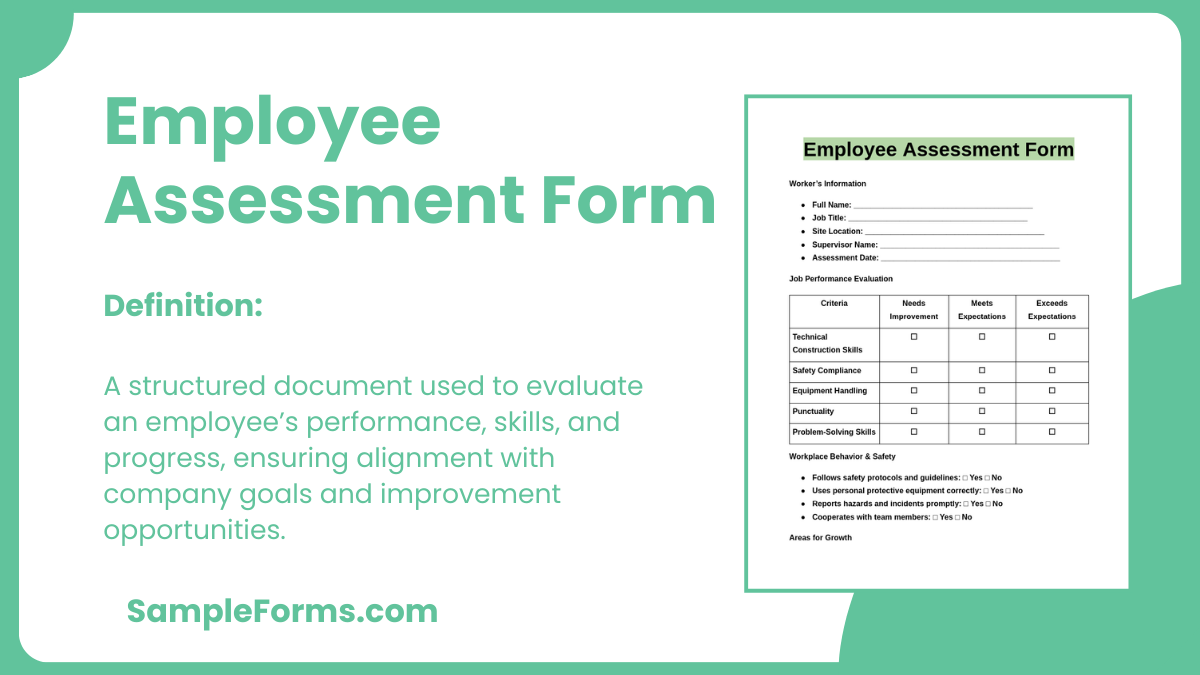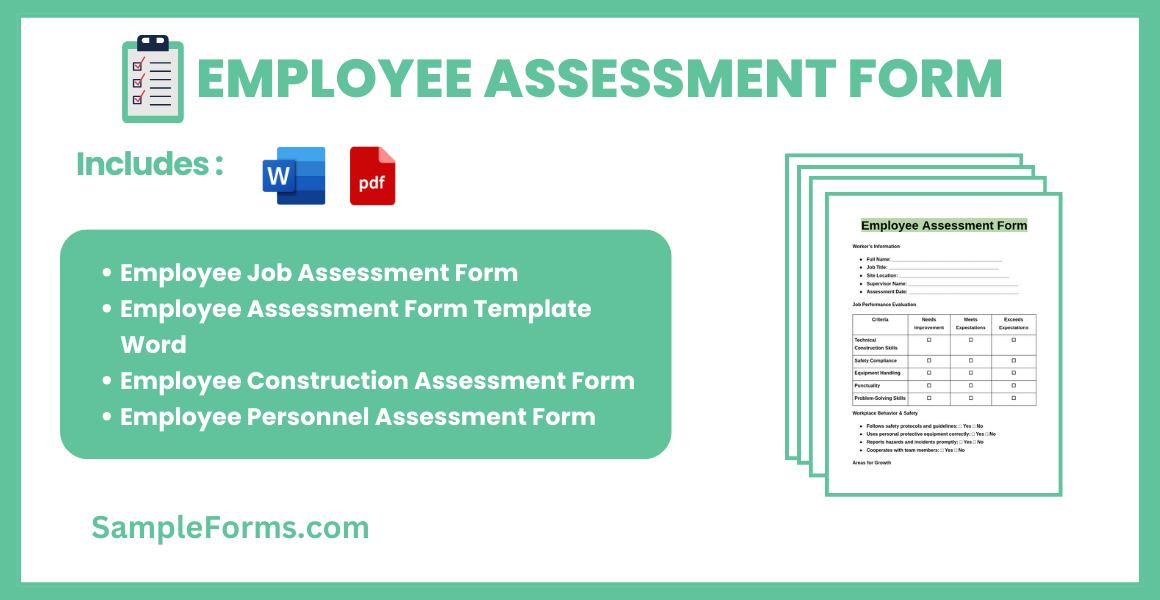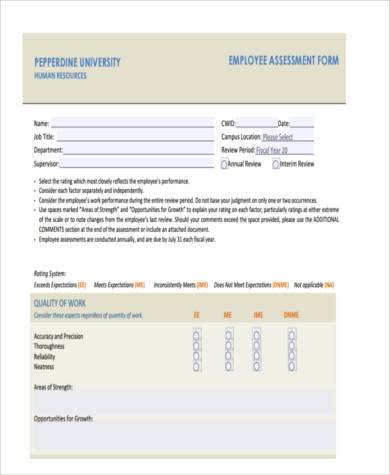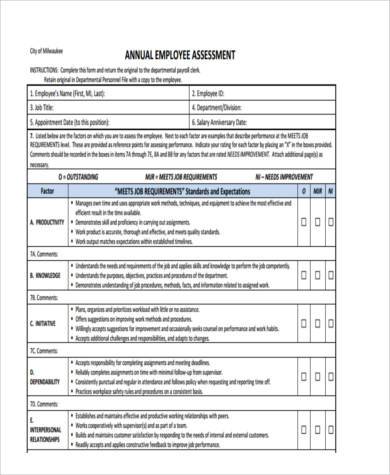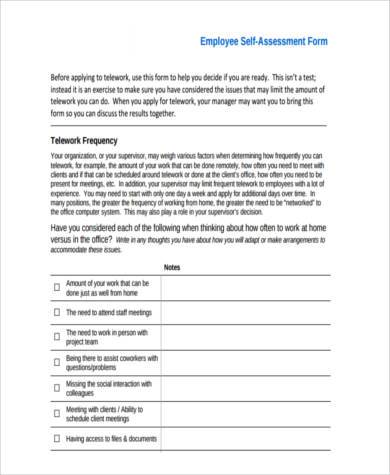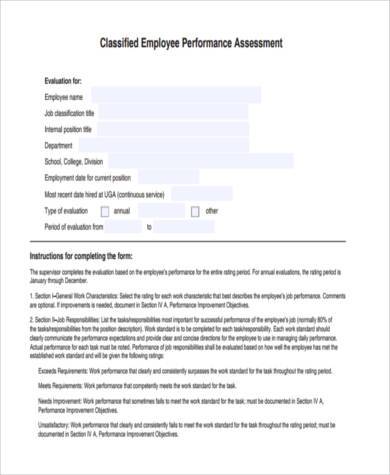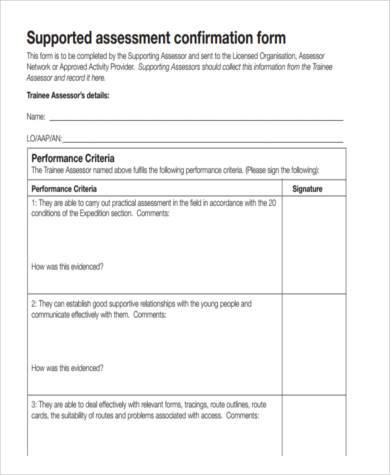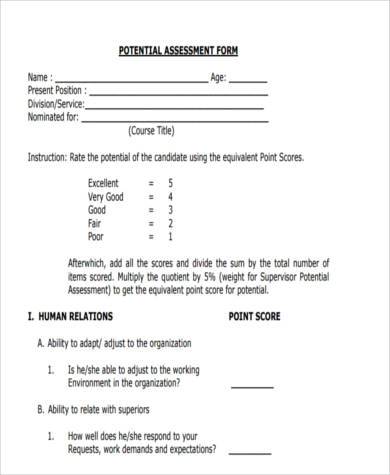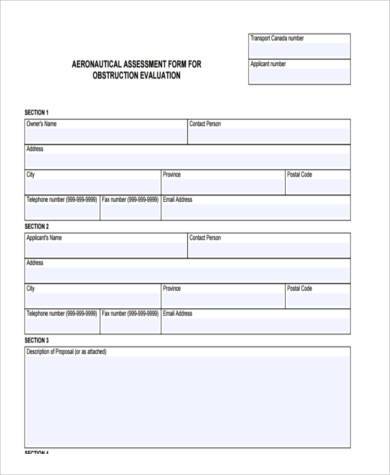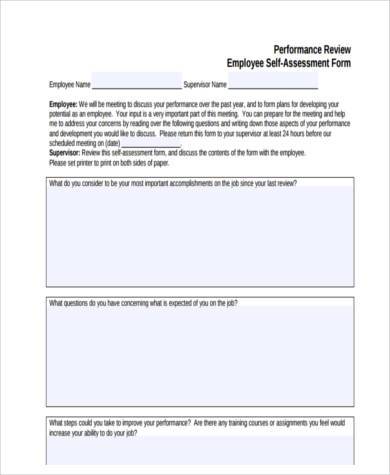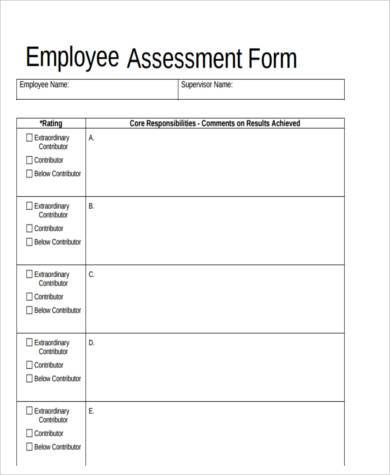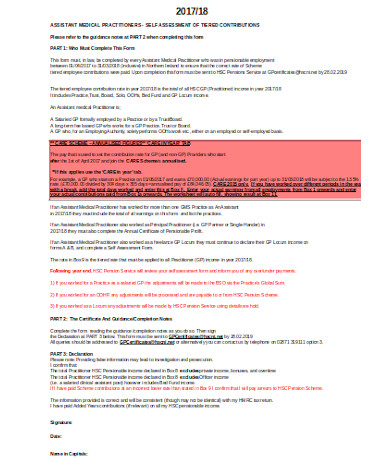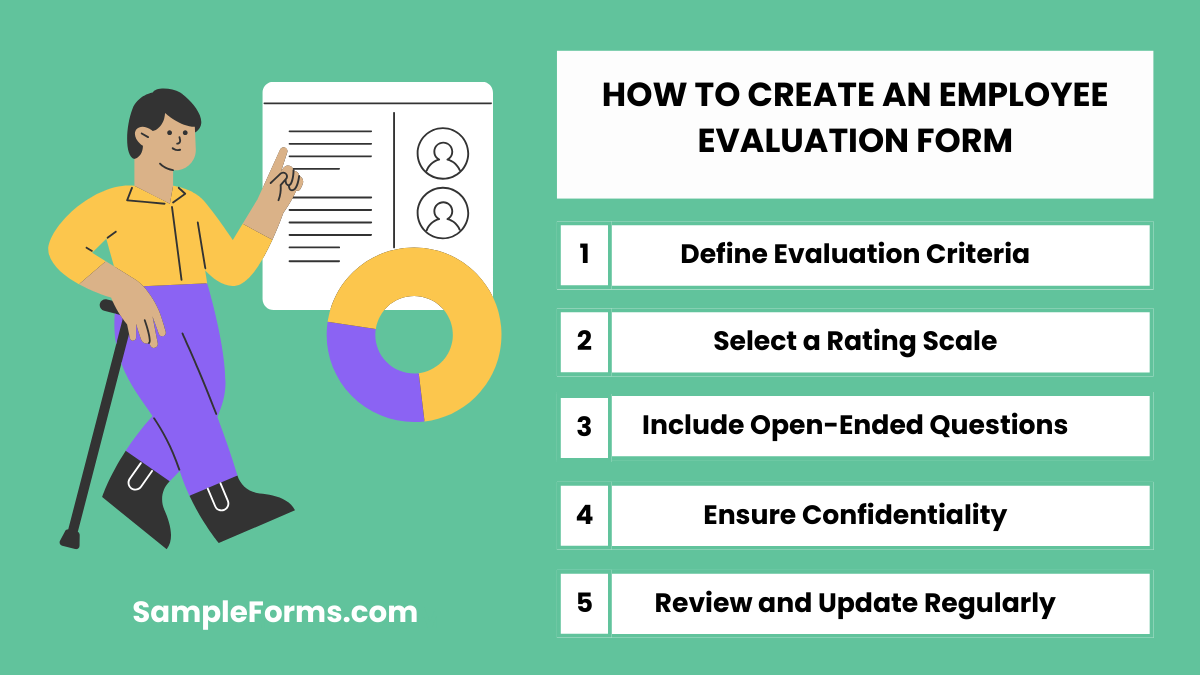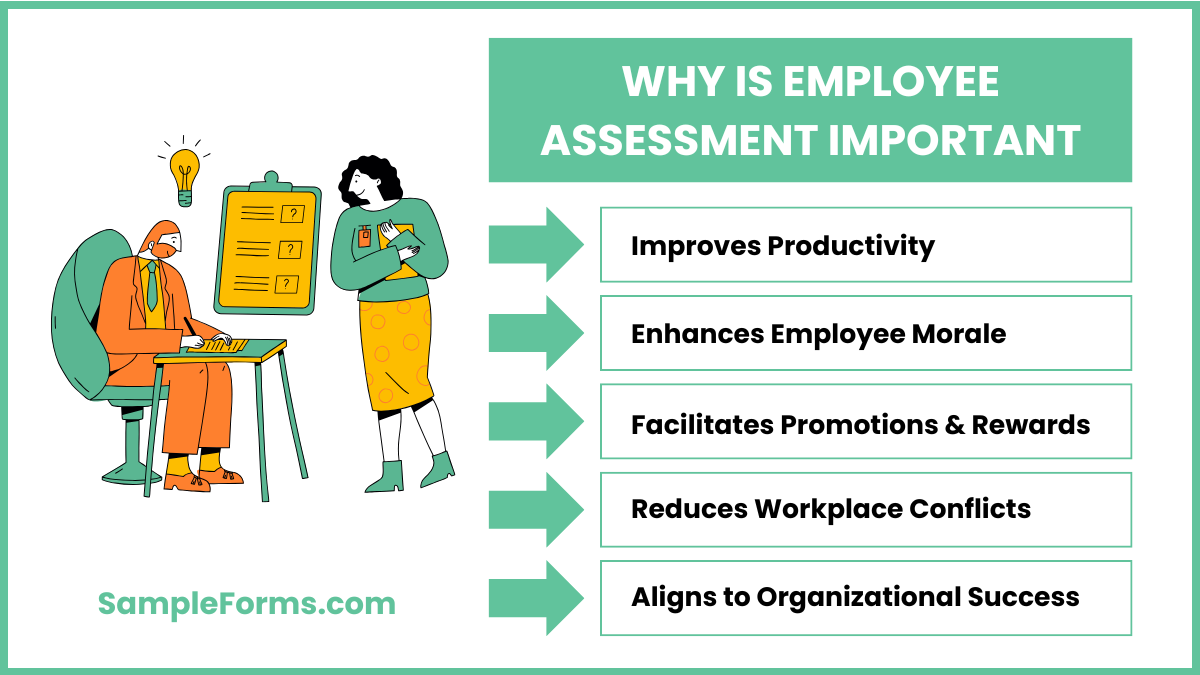An Employee Assessment Form is essential for tracking job performance, identifying strengths, and addressing improvement areas. A well-structured Assessment Form ensures employees receive constructive feedback, helping them grow professionally. These forms typically include sections for job skills, teamwork, productivity, and goal setting. Employers use them to enhance workforce efficiency and create development plans. Whether for annual reviews or probation evaluations, having a clear and standardized Employee Form ensures fairness and transparency in performance appraisals. In this guide, you’ll find expert insights, sample templates, and best practices to create an effective assessment process that drives workplace success.
Download Employee Assessment Form Bundle
What is an Employee Assessment Form?
An Employee Assessment Form is a structured document used by employers to evaluate an employee’s job performance, skills, and contributions. It helps organizations measure productivity, set goals, and provide constructive feedback. These forms typically include ratings for job knowledge, teamwork, problem-solving, and communication. By using this tool, employers ensure fair evaluations and career growth opportunities. It is often used during performance reviews, promotions, or training programs. A well-designed assessment form helps maintain transparency and improves overall workplace efficiency.
Employee Assessment Format
Employee Information
Full Name:
Job Title:
Department:
Employee ID:
Date of Assessment:
Assessor’s Name & Title:
Performance Evaluation
Job Knowledge and Skills
Understanding of Role and Responsibilities:
Technical Competency and Expertise:
Problem-Solving and Decision-Making Abilities:
Work Quality and Productivity
- Accuracy and Efficiency in Tasks:
- Consistency in Deliverables:
- Ability to Meet Deadlines and Targets:
Communication and Collaboration
Effectiveness in Verbal and Written Communication:
Teamwork and Cooperation with Colleagues:
Ability to Handle Workplace Conflicts Professionally:
Adaptability and Initiative
Willingness to Learn and Adapt to Changes:
Proactiveness in Taking Initiatives:
Response to Feedback and Criticism:
Attendance and Punctuality
Consistency in Attendance:
Adherence to Work Schedules and Deadlines:
Time Management and Productivity Optimization:
Leadership and Problem-Solving (If Applicable)
Ability to Lead and Motivate Teams:
Critical Thinking and Problem-Solving Skills:
Delegation and Decision-Making Competency:
Employee Strengths and Weaknesses
Key Strengths Observed:
Areas for Improvement:
Goal Setting and Development Plan
- Short-Term Goals for Improvement:
- Long-Term Career Development Objectives:
- Training or Support Needed:
Final Assessment and Remarks
Overall Performance Rating:
Additional Comments from Assessor:
Employee Feedback on Evaluation:
Signatures
Employee Signature & Date:
Assessor Signature & Date:
Supervisor/Manager Signature (If Required):
Employee Job Assessment Form
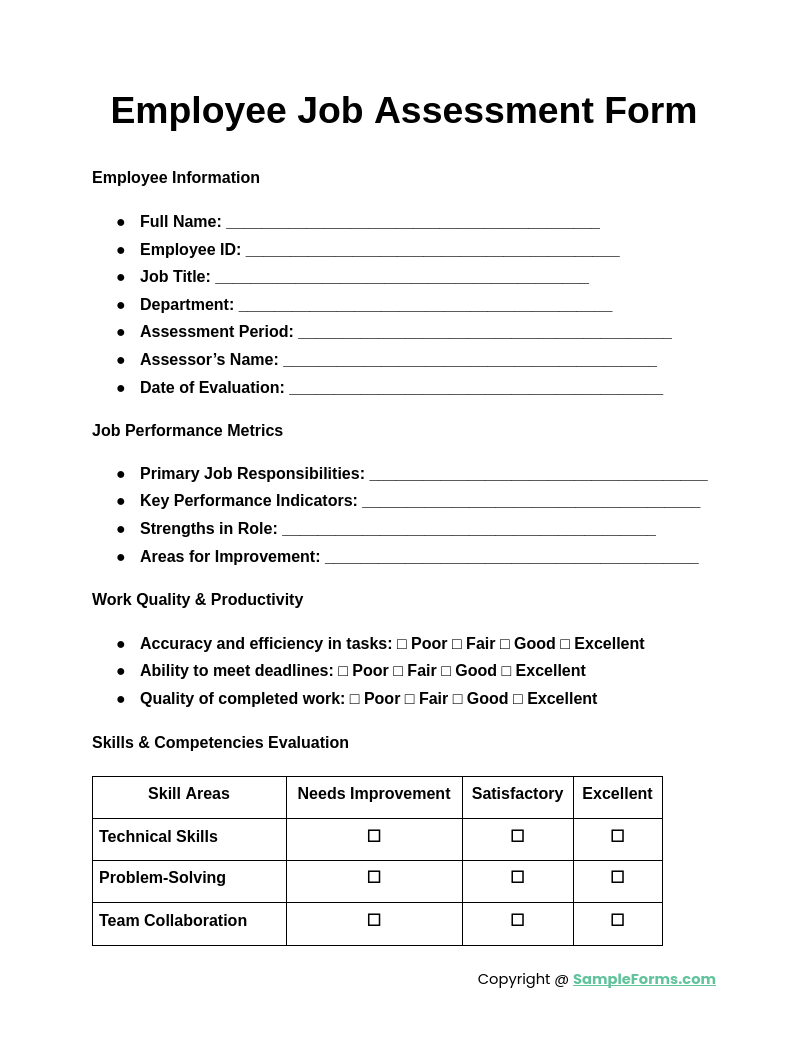
An Employee Job Assessment Form evaluates an employee’s skills, productivity, and job performance. Similar to a Job Assessment Form, it helps employers track progress, identify strengths, and implement development plans, ensuring workplace efficiency and professional growth through structured performance reviews.
Employee Assessment Form Template Word
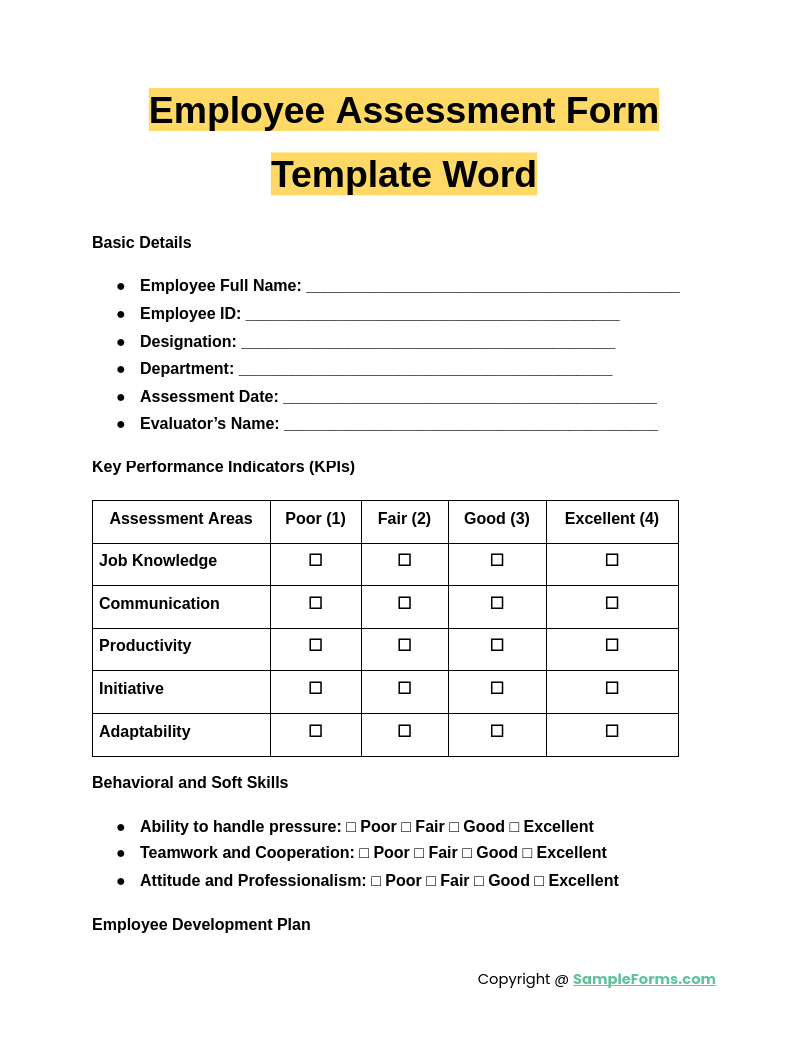
An Employee Assessment Form Template Word offers a standardized format for evaluating employee performance. Like a Student Self Assessment Form, it allows individuals to reflect on their strengths and weaknesses, ensuring structured feedback for career growth and workplace efficiency.
Employee Construction Assessment Form
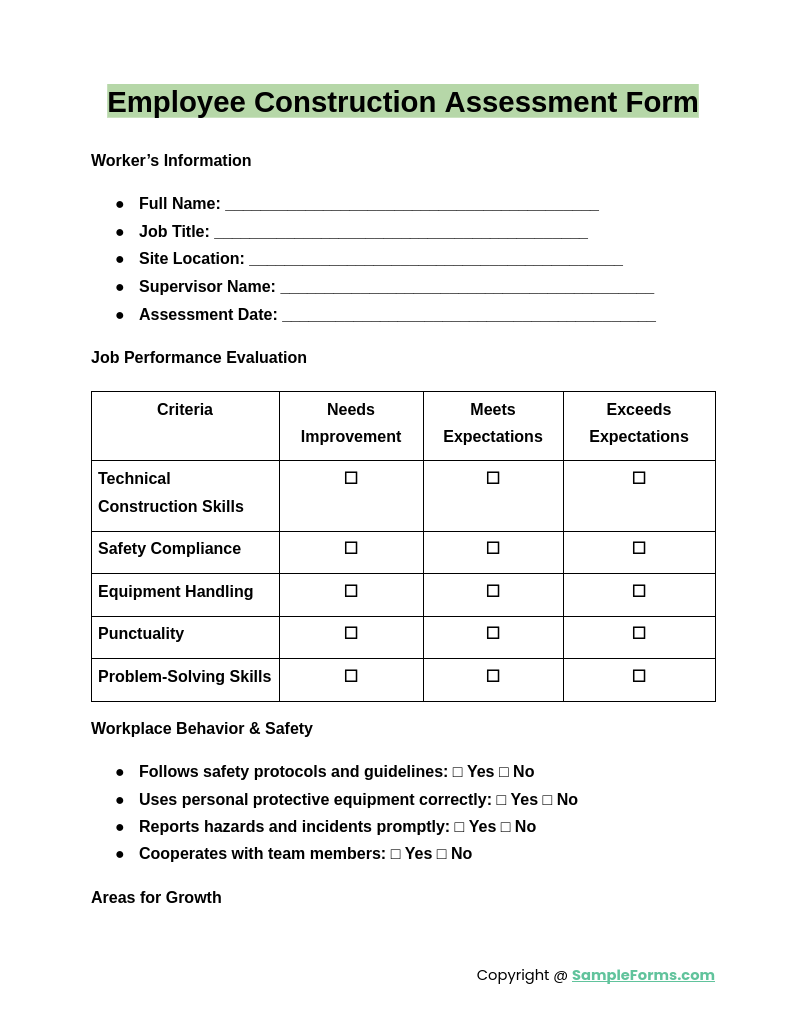
An Employee Construction Assessment Form evaluates construction workers’ skills, safety compliance, and efficiency. Similar to a Supplier Assessment Form, it ensures work quality, adherence to industry standards, and proper performance tracking for improved project management and workforce reliability.
Employee Personnel Assessment Form
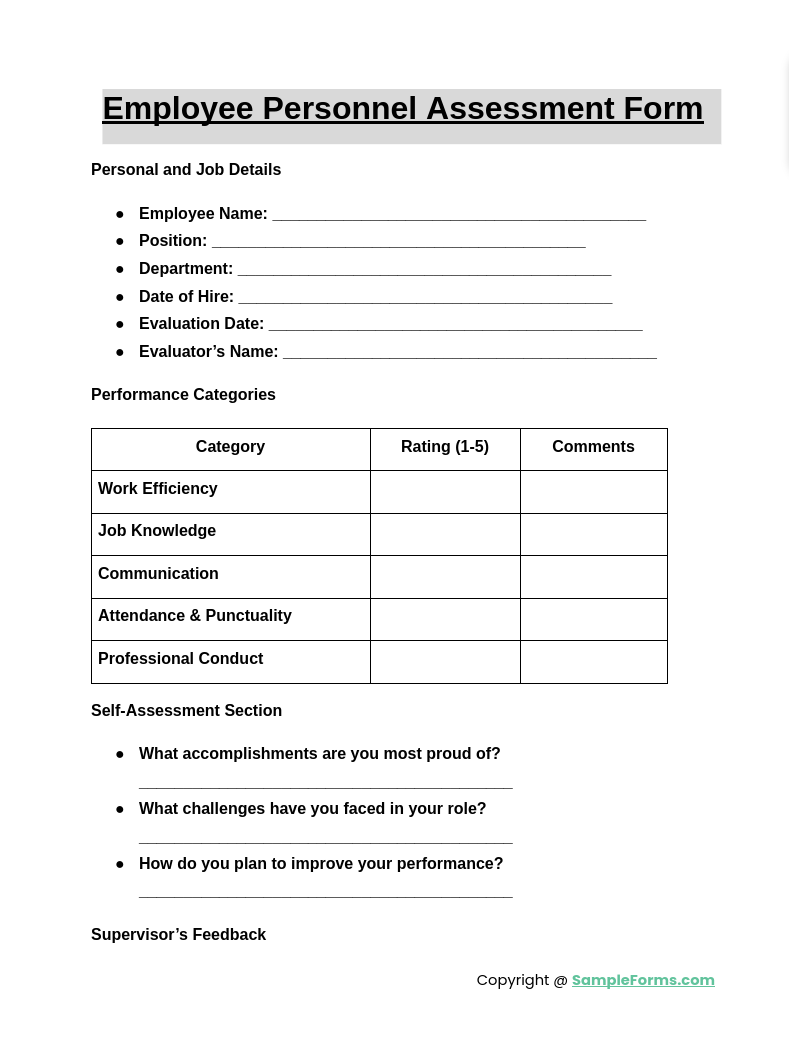
An Employee Personnel Assessment Form reviews employee contributions, communication, and workplace behavior. Like a Vendor Assessment Form, it ensures compliance, evaluates professional capabilities, and helps organizations maintain a skilled workforce through structured assessments and targeted development strategies.
Browse More Employee Assessment Forms
New Employee Assessment Form
Annual Employee Assessment Form
Employee Self Assessment Form
Employee Performance Assessment Form
Employee Health Assessment Form
Employee Confirmation Assessment Form
Employee Potential Assessment Form
Employee Assessment Evaluation Form
Employee Self-Assessment Form in PDF
Employee Assessment Form Example
General Employee Self-Assessment Form
How to create an employee evaluation form?
Creating an Employee Assessment Form involves structuring it for accurate performance evaluation. Follow these steps to design an effective assessment form:
- Define Evaluation Criteria: Identify key performance areas such as communication, teamwork, job knowledge, and problem-solving.
- Select a Rating Scale: Use a numerical or descriptive scale to assess employee performance consistently.
- Include Open-Ended Questions: Allow space for detailed feedback on strengths, weaknesses, and areas of improvement.
- Ensure Confidentiality: Protect employee data and feedback to maintain trust and transparency.
- Review and Update Regularly: Align the form with company goals and industry standards for continuous improvement, similar to an Environmental Assessment Form.
What is the main purpose of employee assessment?
An Employee Assessment Form serves as a tool to evaluate employee performance and growth. Key purposes include:
- Performance Tracking: Monitors employee contributions and job effectiveness over a set period.
- Career Development: Identifies strengths and areas for improvement to enhance professional growth.
- Decision-Making Support: Helps managers make informed decisions about promotions, training, and role adjustments.
- Employee Engagement: Encourages open dialogue between employees and management for continuous improvement.
- Compliance and Standardization: Ensures fairness in evaluations, similar to an Education Assessment Form.
How do I fill out a self-assessment form for an employee?
Completing an Employee Assessment Form requires honesty and accuracy to reflect job performance effectively. Follow these steps:
- Review Job Responsibilities: Align your self-evaluation with the key responsibilities outlined in your job description.
- Assess Your Achievements: Highlight key accomplishments and contributions that have positively impacted the company.
- Identify Areas for Growth: Acknowledge challenges and suggest strategies for improvement.
- Provide Supporting Evidence: Use metrics, feedback, and project results to support your evaluation.
- Set Future Goals: Outline professional development objectives, similar to an Assessment Form for Teacher.
Why is employee assessment important?
An Employee Assessment Form is crucial for maintaining workplace efficiency and employee satisfaction. Key benefits include:
- Improves Productivity: Helps employees understand expectations and work towards company goals.
- Enhances Employee Morale: Encourages recognition and constructive feedback.
- Facilitates Promotions and Rewards: Provides a structured approach to identifying high-performing employees.
- Reduces Workplace Conflicts: Encourages transparency in performance evaluations.
- Aligns with Organizational Success: Ensures continuous improvement, similar to a Work Assessment Form.
How to write an assessment report for an employee?
An Employee Assessment Form should be structured, detailed, and objective. Follow these steps to write an effective assessment report:
- Gather Relevant Data: Use performance records, supervisor feedback, and self-assessments.
- Outline Key Performance Areas: Evaluate skills, teamwork, problem-solving, and communication.
- Use a Clear Format: Organize the report into sections with concise observations.
- Provide Constructive Feedback: Offer balanced insights with both strengths and areas for improvement.
- Include a Conclusion and Action Plan: Summarize key findings and suggest future goals, similar to a Business Assessment Form.
What is an employee assessment test?
An Employee Assessment Form measures job-related skills, problem-solving abilities, and personality traits. Similar to a Wellness Assessment Form, it helps employers evaluate suitability for roles, ensuring an efficient hiring process and workforce productivity.
What is an example of employee evaluation?
An Employee Assessment Form typically includes job knowledge, teamwork, communication, and productivity evaluations. Similar to a School Assessment Form, it provides structured feedback to help employees improve performance and career development.
How to assess skills and competencies?
Assessing skills in an Employee Assessment Form involves reviewing job performance, conducting tests, and gathering feedback. Like an Income Assessment Form, it identifies strengths, gaps, and areas for improvement to enhance employee growth and efficiency.
What is the 5-point scale for employee performance?
The Employee Assessment Form 5-point scale includes: 1-Poor, 2-Below Average, 3-Satisfactory, 4-Good, and 5-Excellent. Like a Project Assessment Form, it provides a clear evaluation metric for consistent performance reviews.
How to write a performance improvement plan for an employee?
An Employee Assessment Form should outline issues, set achievable goals, and provide a timeline. Like a Financial Assessment Form, it ensures structured steps to help employees enhance performance and meet organizational expectations effectively.
Can you still get hired if you fail an assessment test?
Failing an Employee Assessment Form doesn’t always disqualify you. Some employers consider experience and interviews, similar to a Safety Assessment Form, which ensures workplace compliance but isn’t the sole deciding factor.
How do I comment on my own performance?
In an Employee Assessment Form, highlight strengths, acknowledge weaknesses, and discuss improvement plans. Similar to an Infection Control Assessment Form, self-evaluation helps maintain transparency, track progress, and develop professionally within a structured framework.
How do you pass an assessment for a job?
Prepare for an Employee Assessment Form by reviewing job descriptions, practicing relevant tests, and understanding role expectations. Like a Needs Assessment Form, identifying key areas ensures better readiness and improved results in assessments.
What are the best words to describe quality of work?
An Employee Assessment Form often includes terms like efficient, detail-oriented, innovative, and consistent. Similar to an Employee Training Assessment Form, it reflects performance strengths and areas needing enhancement in a professional setting.
Why do companies make you take assessments?
Employers use an Employee Assessment Form to ensure candidates meet job requirements. Like an Insurance Assessment Form, it evaluates risk, skills, and potential contributions before hiring or promotions, ensuring better workforce decisions.
A well-crafted Employee Assessment Form is a vital tool for improving workforce productivity and career development. Whether for annual reviews, promotions, or skill evaluations, it helps employers assess employee strengths and identify areas for improvement. Using structured templates ensures fairness, transparency, and consistency in performance reviews. Employers can also customize forms to align with company goals and industry standards. From self-assessments to peer reviews, the right evaluation approach enhances workplace efficiency. Additionally, integrating a Training Needs Assessment Form helps track employee progress and skill development, ensuring continuous growth and professional success.
Related Posts
-
How to Appeal Medical Assessment Verdict? [ What Is, How Do ]
-
5 Assessment Methods That Promote Content Retention
-
Enquiry Form
-
FREE 5+ Recruiter Performance Review Forms in PDF | MS Word
-
Job Safety Observation Form
-
FREE 4+ Hazard Observation Forms in PDF
-
FREE 5+ Coach Observation Forms in PDF | MS Word
-
FREE 4+ Child Care Observation Forms in MS Word | PDF
-
FREE 4+ Child Observation Forms in PDF | MS Word
-
Preschool Observation Form
-
Student Observation Form
-
Peer Observation Form
-
Lesson Observation Form
-
Content Retention Through Assessment Form [ How to, Importance, Tips ]
-
The Importance of Risk Assessment and Safety Statement [ What Is, How to Conduct ]
